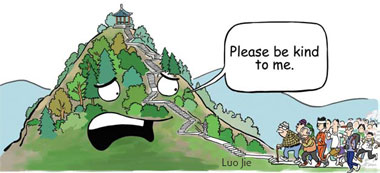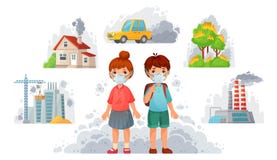Watch video clips “Causes & effects of climate change”, Climate change and its effects on Jamaican farmers (S.S.) Analyze the clips then create a table to site the problems, causes, effects and how this can be solved for report in their groups. Eg.
|
Problems Identified |
Causes |
Effects |
How can this be solved |
|
|
|
|
|
EVALUATION
2. 2.
(a) Identify two environmental issues, and briefly describe how each issue could affect Mr. Henry’community
Environmental issue 1:___________________________________
Negative effect:_______________________________________
Environmental issue 2: ___________________________________
Negative effect: _________________________________________
(b) Provide one recommendation that Mr. Brown could follow to help reduce any of the environmental issues identified above.
3. 3. In the dialogue below, ‘Shorty’ and his friend ‘Longman’ are having a discussion. The discussion is about the method of disposal chosen by Shorty and the type of materials he is throwing away.
Shorty: What happen to you Longman. It is ok dump these pastic bottles and foam in the gully behind Yu don't expect mi to keep dem in mi house man.
Longman: You can't think like that Shorty. You need to remember that our actions have consequences.
(i) Do you agree with Shorty’s method of garbage disposal? Yes or No _________
(ii) Explain why you agree or disagree with Shorty’s method of garbage disposal.
1. 4. (a) June dumps her garbage in the river that runs around the back of her house. Write 2 problems that may arise from her actions.
(a) Write an alternative method that June could use to save the environment.
2. 5. Which of the following would least harm the environment? Place a ü in the box.
|
Disposing of a banana skin on land |
|
|
Throwing a plastic bottle in the sea |
|
|
Dumping some fallen leaves in the back of your schoolyard |
|
(i) Justify your answer to (i) above?
3. 6. Mr. Harry rears cattle and keeps them on a particular section of his property for a long period of time. He said he can’t move them to the other side of the property until they graze the grass way down.
(a) What are your views about Mr. Harry’s action?
(b) What suggestion would you give to him?
4. 7. After spraying his callaloo bed with insecticide, Mr. Brown poured the remaining chemical into a nearby stream and washed his hands.
Which of Mr. Brown’s activities is likely to have the most damaging effect on the environment?
(a) Washing his hands (b) pouring the chemical into the water
(c) spraying the callaloo (d) using insecticide
Follow up Practice Exercises
Lesson Title: The Environment
Grade Level: 6
Duration: 1 Hr
Focus Question: Why is it important to care for the environment?.
Objectives:
By the end of the lesson, students will be able to:
-
Outline the effects of human activities on the environment.
-
Show concern for the impact of humans on the environment.
-
Be aware of their responsibility to preserve the environment.
Materials:
-
Chart paper/markers
-
Multimedia projector/chromebooks
-
Images of polluted and clean environments
-
Recyclable materials (plastic, paper, etc.)
-
Student journals
-
STEM kit (magnifying glass, thermometer, soil sample jars
clip on human impact on environment
-
Role cards for group work
5E Model Lesson Plan
1. Engage (5–7 minutes)
Activity: Image Reaction + Think-Pair-Share
-
Display two images: one of a healthy environment, the other of a polluted one.
-
Ask: "What do you notice? How do these places make you feel?"
-
Students turn and talk to a partner to share their feelings.
-
Teacher records responses on the board.
Purpose:
To spark curiosity and empathy; activate prior knowledge.
2. Explore (15 minutes)
Activity: STEM Investigation - Environmental Walk or Station Activity
-
Students rotate through stations or use STEM kits to explore samples of soil, water, and air quality indicators (e.g., clean vs. dirty water, temperature differences, etc.).
-
Record observations in journals.
-
Discuss: What might have caused changes in soil/water/air?
Differentiation:
-
Mixed-ability pairs.
-
Visual aids and simplified instructions for students with learning needs.
-
Extension prompts for early finishers: "What might this environment look like in 10 years if we continue this trend?"
3. Explain (10–12 minutes)
Activity: Teacher-Guided Mini Lesson + Video Clip
-
Show a short video clip on human impact (pollution, deforestation, overfishing).
-
Define environment, conservation, and pollution.
-
Discuss the effects of deforestation, littering, and pollution using real-world examples.
-
Create a concept map together: Human Activities → Effects → Solutions
STEM Integration:
-
Highlight how scientists use data and technology to monitor environmental changes.
4. Elaborate (15 minutes)
Activity: “Eco-Action Plan” Group Task
-
In small groups, students choose one negative human activity and come up with a plan to reduce its impact (e.g., reduce plastic, plant trees, recycle more).
-
Each group presents their plan in a 2-minute skit, poster, or short jingle.
Differentiation:
-
Role assignments in groups (illustrator, writer, speaker, researcher).
-
Visuals and sentence starters provided for support.
-
Higher-level learners encouraged to propose creative STEM-based solutions.
5. Evaluate (10 minutes)
Activity: 3-Tier Evaluation + Reflection
-
Students respond to exit ticket prompts (tiered by readiness level).
-
Teacher uses rubric to assess presentations and reflection journals.
Three-Tier Evaluation:
| Tier | Task | Assessment Focus |
|---|---|---|
| Tier 1 (Support) | Match human activities (cutting trees, littering) with effects using a worksheet. | Identifies and outlines effects of human actions. |
| Tier 2 (On-Level) | Write 3 sentences explaining why we must care for the environment. | Shows concern and awareness. |
| Tier 3 (Advanced) | Propose and justify a solution to one environmental issue in their community. | Demonstrates critical thinking and responsibility. |
Closure (3 minutes)
-
Revisit focus question: "Why is it important to care for the environment?"
-
Students share one thing they will do to help care for the environment this week.
Extension/Homework (Optional):
-
Students research and bring an item from home that can be reused or recycled and explain how they repurposed it.




Hi miss I havd completed the homework
ReplyDeleteI have done the work
ReplyDeleteI REALLY LIKE THE WORK .miss Bowes 😁
ReplyDeleteHi miss I really like the word
ReplyDelete😁
Hi miss. I did the work.❤️❤️
ReplyDeleteGood night miss it's Sanoya I got 100% on different kinds of pollutions on activity 5.💗💓🩷🩷🩷🩷💞
ReplyDelete